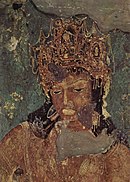Prithivishena I
| Prithivishena I | |
|---|---|
| Mahārāja | |
| Reign | c. 360 – 385 CE |
| Predecessor | Vakataka |
| Vakataka dynasty c. 250 - 510 CE | ||||||||||||||||
|---|---|---|---|---|---|---|---|---|---|---|---|---|---|---|---|---|
|
||||||||||||||||
| Nandivardhana-Pravarapura Branch | ||||||||||||||||
|
||||||||||||||||
| Vatsagulma Branch | ||||||||||||||||
|
||||||||||||||||
Prithivishena I (
Despite the expansion of the
One of the most important events of Vakataka history took place during the later part of Prithivishena's reign when his son Rudrasena II married the Gupta princess Prabhavatigupta.[5] This marriage secured an alliance between the two most powerful royal houses in India at the time. It was probably the Gupta emperor Chandragupta II who proposed the marriage of his daughter to the Vakataka prince, as he desired a cooperative ally on his southern border while his armies were operating in Malwa and Gujarat.[6]
Prithivishena's contemporary to the south was his cousin Vindhyasena of the Basim or Vatsagulma branch of the Vakataka dynasty. The relationship between the two branches of the dynasty appears to have been quite cordial at this time, with the main branch headed by Prithivishena probably enjoying a nominal overlordship over the Vatsagulma branch.[1] Prithivishena likely provided material aid to Vindhyasena as the latter carried out the conquest of the Kuntala country, and thus the rulers of the main branch came to be known as "lords of Kuntala."[7]
In later Vakataka inscriptions, Prithivishena is described as a righteous conqueror and possessing the qualities of straightforwardness, honesty, humility, compassion, and purity of mind.[5] He was called a dharmavijayin ("one who becomes victorious through virtue") and was compared to the epic hero Yudhishthira of the Mahabharata. Like his father Rudrasena I, Prithivishena was also a worshipper of Shiva.[8] Prithivishena probably lived to old age and had a large family, for the Vakataka inscriptions describe him as a patriarch surrounded by sons and grandsons.[9] Upon his death, he was succeeded by his son Rudrasena II.
References
- ^ ISBN 9788120800434.
- ^ D.C. Sircar (1997). Majumdar, R.C. (ed.). The Classical Age (Fifth ed.). Bharatiya Vidya Bhavan. p. 179.
- ^ A.S. Altekar (1960). Yazdani, Ghulam (ed.). The Early History of the Deccan. Oxford University Press. p. 173.
- ^ Altekar (2007), p. 101
- ^ ISBN 978-81-317-1677-9. Retrieved 10 August 2016.
- ^ Altekar (2007), pp. 101–102.
- ^ Altekar (1960), p. 172
- ^ Sircar (1997), p. 178
- ^ Altekar (1960), pp. 171–172


